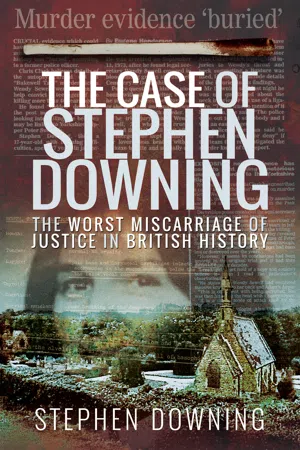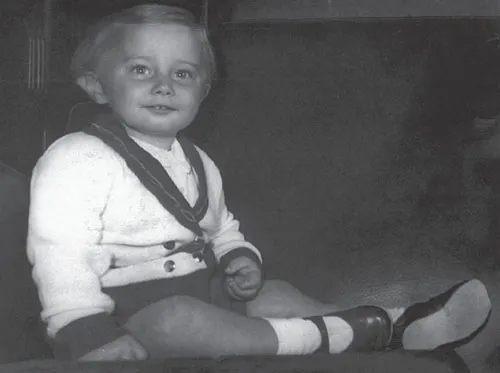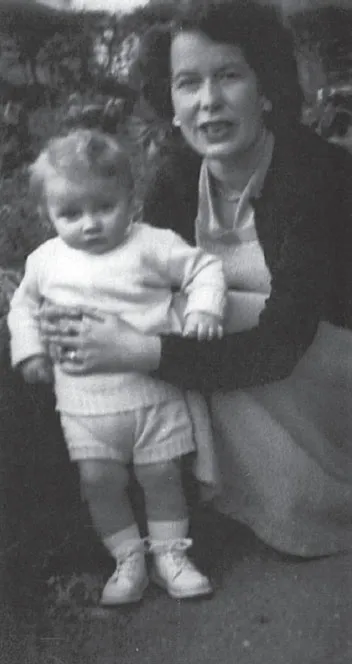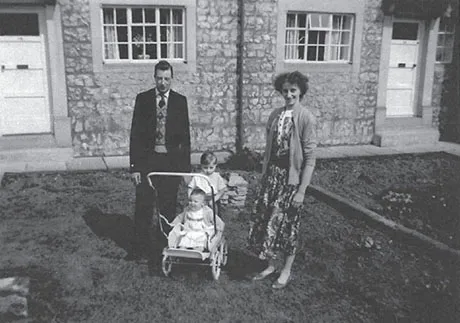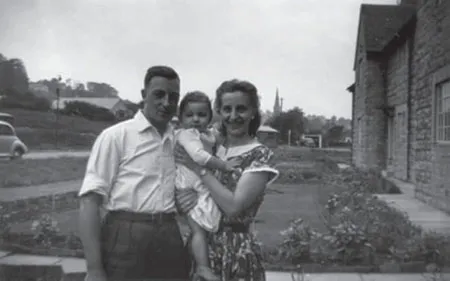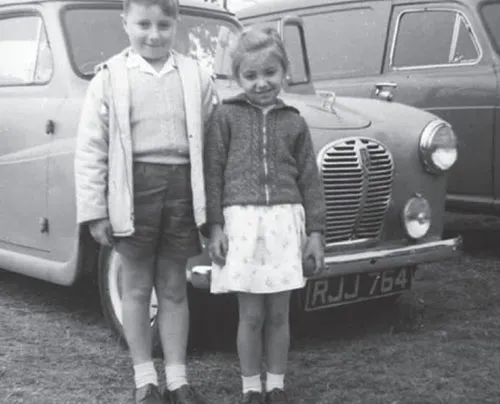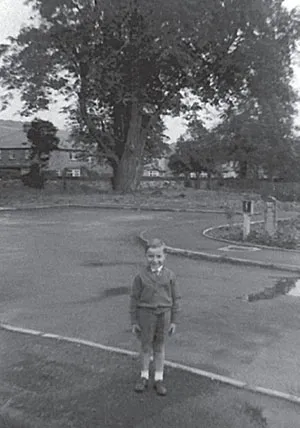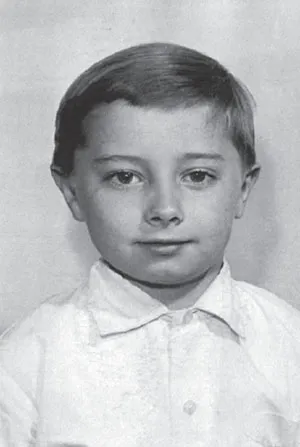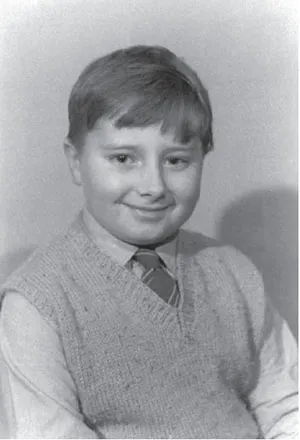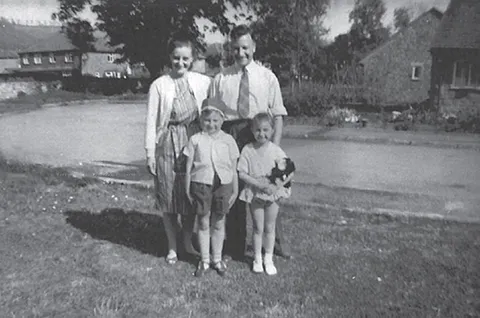![]()
Chapter 1
Birth and Early Life
I was born on Sunday, 4 March 1956 at home. My mother Juanita, known to everyone as Nita, had been adopted at the age of 3 and brought up in the Bowring Park district of Huyton-with-Roby in Liverpool. She had married my father, Ray, a young RAF man, in 1954 and we lived at 50 Burton Edge in Bakewell, Derbyshire, sharing the house with my grandparents on my father’s side until they were allocated a council house. Three years later to the day, on Wednesday, 4 March 1959 my sister Christine – Chrissie to everyone – was born in our new family home at 16 Holywell Flats in Bakewell.
Mum and Dad’s wedding 1954.
Me with Dad’s cousin Dora Harbottle.
My sister Chrissie and me with Grandma Dora (Dad’s mother).
Mum and Dad with Chrissie 1962.
Following the loss of my grandfather, Percy, a short while after my sister’s birth, my grandmother, Dora, moved into 11 Holywell Flats, having exchanged with her niece and husband. However, as we got older, my mother struggled to get the pram up and down the stone steps to the upstairs flat, so we did a swap with my grandmother and we moved into number 11.
We had many happy years at the flat, which was located on a very quiet estate, with perhaps no more than three or four people owning a car. We bought a second hand Austin A40 so my father could get to work quicker as he had joined the ambulance service. In those days it really was ‘swoop and scoop’ and get them to the nearest hospital as quick as the ambulance would allow.
As we grew older it was no longer acceptable for us to share a bedroom so our parents applied for a transfer and in 1967, when I was 11 and Chrissie was 8, we moved into the house my sister still calls home. My mother didn’t like the house from the start but beggars can’t be choosers with council homes so she was stuck with it. The first thing on the to-do list was put light bulbs in the rooms as the previous tenant had taken them with her. My mother insisted on decorating the kitchen orange and white, which I guess was to brighten the place up. Like most households at that time, the kitchen was the hub of the home and where friends would congregate when they called round for a cup of tea.
Me and Chrissie with our Austin A40 circa 1964.
Scarborough summer 1960: Dad, me, Grandma Eva (Mum’s mother), Chrissie and Mum.
Money was tight and my parents were careful spenders. The most extravagant purchase was the car. Holidays were few and far between and when we did go away, it would be a week in Scarborough where my grandmother’s sister had a bed and breakfast or a week in Liverpool with my mother’s parents. One of my dad’s work colleagues had a small caravan in Llandudno, North Wales, and we enjoyed a week there. It wasn’t until later, when my father left the ambulance service and started work as a coach driver, that we had several holidays in Cliftonville in Margate on the Kent coast. My last trip was in August 1973, just a few weeks before my arrest.
I was a year late starting Bakewell Infant School because I had bronchitis and pleurisy. It was so bad that the doctor wouldn’t allow me to be moved to hospital as he didn’t think I’d survive the journey. Instead, a bed was made up in the living room from two armchairs tied together. It wasn’t the best of setups but I enjoyed being there. My mother and grandmother would sit up alternate nights to watch over me and as I didn’t sleep well, I’d sit up and chat with them as they read stories to me. Once I started school, I found it hard to make friends as my peers were already settled and I had to try and fit in.
Me, aged seven with Mum, Dad and Chrissie.
A family photo to treasure 1964.
Eventually I did make friends and they would stay with me as I progressed through Bakewell Methodist Junior School and Bath Street Boys’ School, which was Church of England. Most of us lived within a minute or two of each other and would meet up in the evening after school and at weekends. I left school aged 15 on a Friday morning after an assembly full of hymns and a lecture by Headmaster Harry Schofield, who was also the local magistrate. I sat at the front with the other leavers, facing the crowd of younger pupils. Even though I was leaving school with no qualifications (I only excelled in Woodwork), he told everyone that we had done well and were well prepared for what lay ahead. He then shook each of us by the hand as we filed out of the hall. I had been growing my hair long but my mother had been badgering me to get it cut and that morning she had thrust some money into my hand, so off I went to the barbers before meeting a mate in a nearby café where we played the pinball machines for a couple of hours before drifting home. As I walked through the door, I could have cried when my mother commented on my hair cut and told me she’d liked it long! It would be many years before my hair saw scissors again.
Me aged eight at Bakewell Methodist Junior School.
So now I was in the big wide world aged 15 but with a reading age of an 11-year-old. Fortunately, I found work quickly at Bloomers the Bakers, home of the mouth-watering Bloomers’ Original Bakewell Pudding, which had a shop and restaurant on Matlock Street in the town centre. I loved working there. Perhaps it was my true vocation. One of my proudest moments was when a bread wheatsheaf I had designed and baked was chosen as the centrepiece of the harvest festival in the local parish church. The local vicar at the time, who I think may have been Rev Urquhart, had asked for one and Eric Bloomer, the boss, thought it was something I could do.
Despite my poor learning ability at school I had developed a mischievous sense of humour and had a keen eye for observation. One day I asked why there were only gingerbread men and never any women. Eric’s son, John, suggested I make one and an example of my handiwork had many people chuckling, though John’s mother-in-law was not impressed and tut-tutted when she saw it in the bakehouse. My gingerbread woman didn’t go any further, which was a disappointment, not just to me but to the customers who thought she was hilarious and had already put in their orders. I had a good time at Bloomers and despite my employers taking a liking to this agreeable, simple lad from the council estate, after a year they decided to dispense with my services. I can’t pretend I don’t know why – I was more than often late for work.
My next job lasted just five days. I worked for a plasterer but was dismissed almost immediately and despite asking why, I was never told. I then started work at Cintride, an engineering work...
